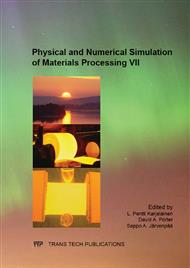p.734
p.741
p.747
p.753
p.757
p.763
p.769
p.777
p.782
Computational and Experimental Investigation on Thermal Conductivity of SiС Particle Reinforced Al-Matrix Composite Containing Pores
Abstract:
In this paper, the finite element method (FEM) was implemented to determine the effective thermal conductivity of SiC particle reinforced Al matrix (SiCp/Al) composites containing various pores and that method was validated by experimentation. A commercially available finite-element package ANSYS is used to for this numerical analysis. Multi-particle and pores random distribution models based on the effective medium approximation (EMA) scheme are constructed to simulate the microstructure of composite materials for various porosities ranging from 0.96 to 10.58%. The SiCp/Al composites were fabricated by the pressureless infiltration method. This study shows that the smaller pores contained in the composite results in sharp reduction of thermal conductivity, when the porosity is up to 2.66 vol.%, the thermal conductivity of composite is found to decrease by about 9.02%. The experimentally measured thermal conductivity values are compared with the numerically calculated ones and also with the existing theoretical and empirical models. The values obtained from finite-element analysis (FEA) are found to be in reasonable agreement with the experimental values.
Info:
Periodical:
Pages:
769-776
Citation:
Online since:
July 2013
Authors:
Price:
Сopyright:
© 2013 Trans Tech Publications Ltd. All Rights Reserved
Share:
Citation:


